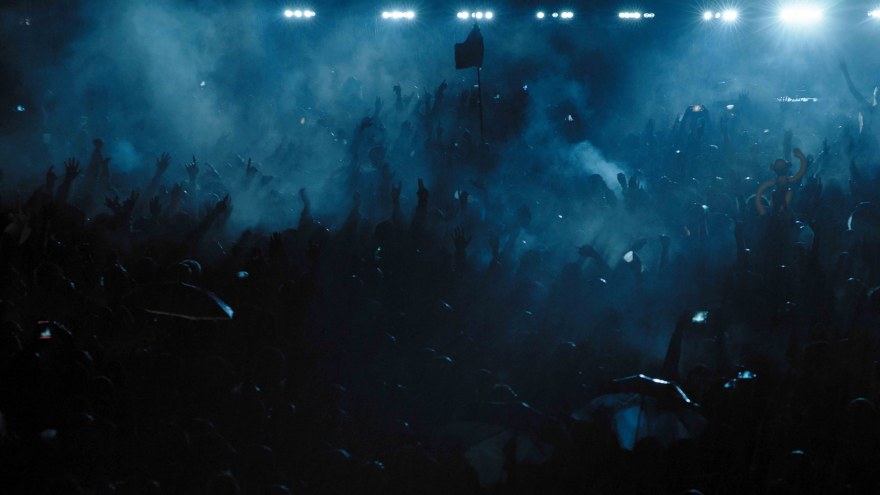Tea time with Cultes
Interview with the collective (LA) HORDE, co-directors of Cultes
Are you specifically interested in the question of rituals, and are you working on other projects on the subject?
In our film Cultes, as the name indicates, we aim to explore how a specific cult – namely, festivals – manifests itself, the practices involved, the performances that it ritualizes. Slam, mosh pit, circle, wall of death, and so on, all constitute a combination of highly-symbolic gestures and it’s quite natural for us to take hold of these forms and scrutinize them by multiplying the viewpoints around them. Our starting point was to take a look at the festival form, which is already fifty years old – from Woodstock up to today – and which has evolved from an anti-capitalist count-cultural space to the latest manifestation of the culture industry, a capitalist sanctuary filled with rites and symbols. Nowadays, “purists” criticize festivals and that pushed us to look into the ambivalence of festivals as a manifestation. Was there ever only one pure, original form of the festival? What original myths lead to reactualizing symbols that no longer have any meaning in certain contexts: displaying tattoos that say “Peace & Love” amid pop symbols like Bart Simpson. What physical forms emanate from festivals and what sort of spiritual and physical experience do festival-goers have? These sorts of questions are frequently present in our work in different forms because for us there is always a form of ritual in repeated, dance acts.
Why were you interested in the relation between rituals of life and situations of death?
In our work, we try to find the grey area, to think about deep-seated questions in a less Manichean way while maintaining a critical outlook. For this project, questions of life and death are more tied to the symbolic value of transformation than to passage from one state to the next. We deal with more than one mix of urges – the urge to live, the death drive – and formulated several questions to build the film around. Is it still possible to have a spiritual experience in these new temples of consumption? Can spectators create their own subversive experiences as so many individuals that make up a throng? These were the questions we kept in mind throughout filming and helped us hone our gaze to identify and collect images that corresponded to the questions. As we scanned the crowds with our cameras, we tried to capture moments of grace hovering between disappointed paganism and animal spirituality, jubilation and concern, ecstasy and the down, disappointment and light.
How did you go about capturing the images of the crowds?
We filmed the crowds over three nights, which let us multiply the points of view. We used three different camera setups. With a Phantom on a crane, we were able to film all of the big slow-motion shots. An Alexa Mini, also on a crane, allowed us to fly over the audience in a more pictorial way. And finally we used an Alexa LF on a stand to scan the crowd from a distance, from behind, using a very long focal length and the effect of heavenly surveillance.
What role does water play in Cultes? How important is it?
In dreams, like in myths and fairytales, water, along with the forest and the earth, is the greatest symbol for the unconscious. Water is deeply attached to the origins of existence, to the waning of life and death. But the symbolism of water is also multiple, bringing together several contradictory notions. There is calm water versus fast flowing water. Clear, beneficial water that you drink from springs and fountains contrasts with the mortal waters of drownings and floods. Water is an element of purification as well as of punishment, birth as well as drowning, of rites of initiation as well as flight towards something better. It is a plural element that allowed us to reinforce the ambivalent relationship between what we would like to establish among the film’s different elements.
Have you discovered any advantages that the short film form offers?
Short films are a very free form that let you leave behind the great canons of fiction and engage in disruptive stories. They also give your body the time to express itself, to let loose a universal language that viewers can read. And, without burying your head in the sand, the format also allows you to gather enough funds to put something together.
What works did you draw from?
Hieronymus Bosch’s Garden of Earthly Delights was a big source of inspiration, especially for the film’s structure. It let us think about origins, and thereby to bring into being the moment the festival’s site was under construction, before it could hold any crowds. We also watched a lot of videos of festivals on YouTube: very personal ones, where a bunch of friends film themselves in places and talk directly to the camera, others that imitate Jackass where groups reproduce the same themes we’ve seen over and over again on the internet – binge drinking, slipping in the mud, etc. But we also watched aerial views from drones that film the crowds’ movements, mosh pits, walls of death, and so on. And lastly, Dave Markey’s documentary 1991: The Year Punk Broke where there’s a clip of a fan drinking a beer on the ground while Nirvana play Negative Creep.








